Equipments
Our main research interest is investigating anomalous behavior of solids. We are particularly interested in unconventional superconductors with a strong focus on ruthenates, Fe-based superconductors, uranium compounds, and organic superconductors.
We are able to grow high-quality single-crystals using furnaces such as a floating-zone furnace with temperatures up to 2500 Kelvin and various atmospheres up to 10 bar pressure. Samples are characterized by energy-dispersive X-ray spectroscopy using X-ray diffractions, and our crystals are used for collaboration researches with other laboratories all over the world.
The interesting behavior described above emerges only at temperatures much lower than room temperature. In order to investigate properties of these phenomena, we use measurement techniques such as electrical resistivity, magnetic susceptibility, specific heat and nuclear magnetic resonance (NMR), in temperatures of down to 20 milli-Kelvin and in magnetic fields up to 18 Tesla.
Superconductivity and other phenomena sometimes arise under pressure. We are able to apply pressure up to 10 GPa using pressure cells. NMR and electrical resistivity measurements are performed under such a high pressure.
Thus, we specialize not only in crystal growth but also in many measurement techniques that cover a wide range of temperature (0.02 - 2500 Kelvin), magnetic fields (0.1 -180000 Gauss), and pressure (- 10 GPa). This allows us to study and understand many fascinating phenomena.
We are also active in developing measurement techniques to probe properties of solids more accurately and precisely under extreme conditions.
Material Synthesis
Box Furnace
 Upper: Super khanthal furnaces. They reach 1600 °C.
Upper: Super khanthal furnaces. They reach 1600 °C.
Lower: Muffle furnaces. They reach 1050 °C.
X-ray Diffractometer
 X-ray diffractometer for identification and characterization of samples.
X-ray diffractometer for identification and characterization of samples.
Three Zone Tube Furnace
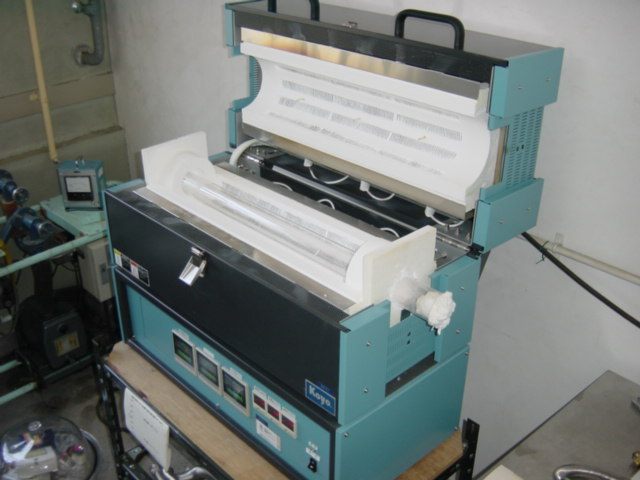 Temperatures (Max. 1200 °C) in three zones can be controlled independently.
This is useful for single crystal growth by chemical vapor transport.
Temperatures (Max. 1200 °C) in three zones can be controlled independently.
This is useful for single crystal growth by chemical vapor transport.
Isotope Furnace
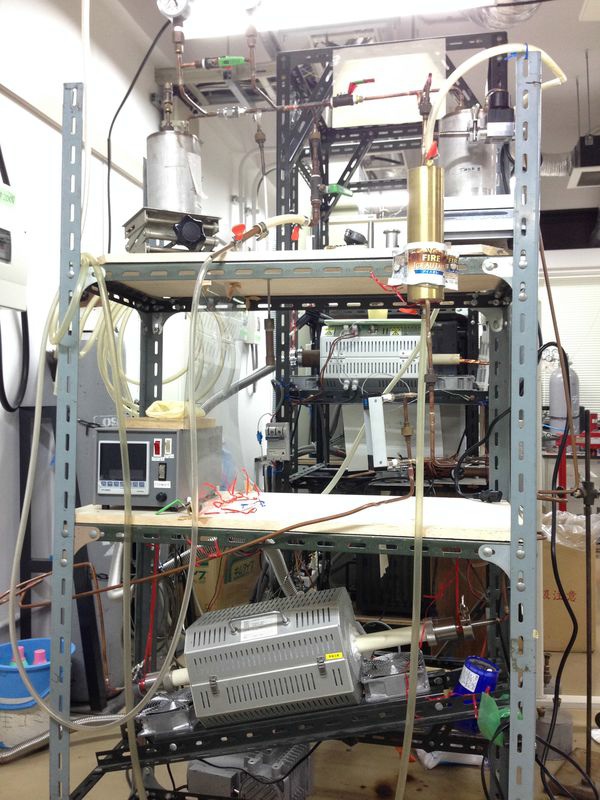 This furnace is used when performing isotope exchange.
Isotope exchange is achieved by annealing samples while circulating isotope gas in the furnace.
This furnace is used when performing isotope exchange.
Isotope exchange is achieved by annealing samples while circulating isotope gas in the furnace.
SEM and EDX
 SEM: Scanning Electron Microscope
SEM: Scanning Electron Microscope
EDX: Energy Dispersive X-ray spectroscopy
Die Bonder
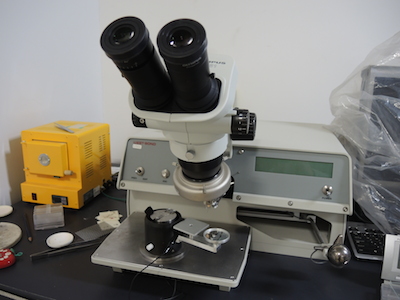 Die bonder is used for making small devices.
Die bonder is used for making small devices.
Arc Furnace
 This furnace is used for making alloy samples or welding metals.
This furnace is used for making alloy samples or welding metals.
Floating Zone Furnace
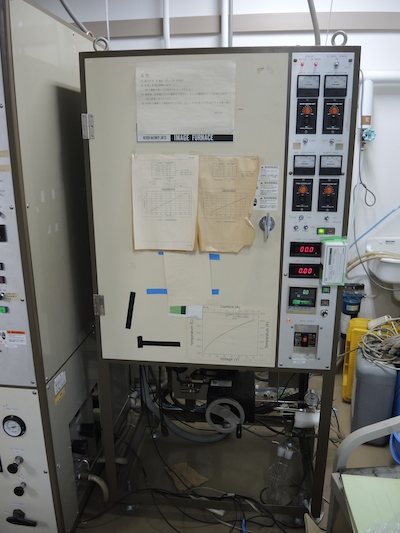 This is mainly used for single-crystal growth of ruthenates.
This is mainly used for single-crystal growth of ruthenates.
Laue X-ray Diffractometer
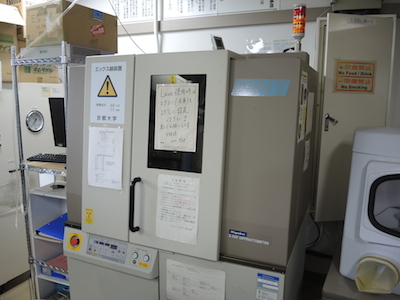 This is mainly used for crystal orientation analyses of samples.
This is mainly used for crystal orientation analyses of samples.
Measurements at Low Temperature and in High Field
3He Refrigerator (Heliox)
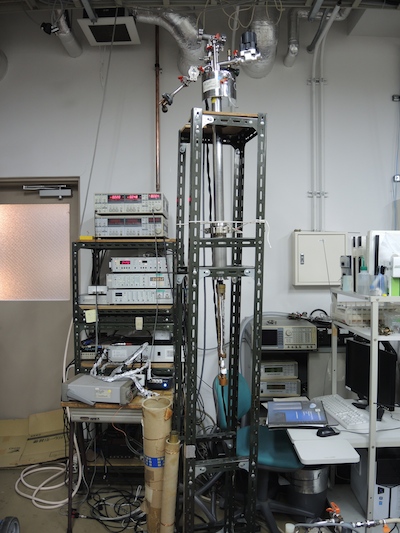 Helium 3 refrigerator (Oxford Instruments) reaching as low as 0.3 K.
Helium 3 refrigerator (Oxford Instruments) reaching as low as 0.3 K.
Three-Axis Vector Magnet
 This consists of three superconducting magnets, and
they reach 1 Tesla, 0.2 Tesla, 0.2 Tesla, respectively.
We can control the direction of field.
This consists of three superconducting magnets, and
they reach 1 Tesla, 0.2 Tesla, 0.2 Tesla, respectively.
We can control the direction of field.
Dilution Refrigerator (Cryoconcept)
 There is a refrigerator in the 11 Tesla magnet (blue cylinder).
This system can reach 16 mK + 11 Tesla.
There is a refrigerator in the 11 Tesla magnet (blue cylinder).
This system can reach 16 mK + 11 Tesla.
Two-Axis Vector Superconducting Magnet + Dilution Refrigerator (Oxford)
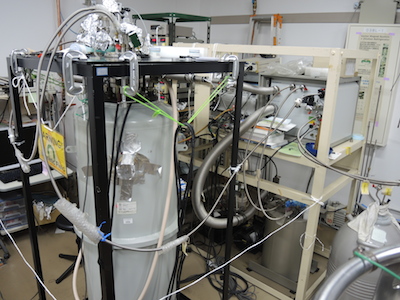 A vector magnet and a dilution refrigerator.
This can control the direction of field.
This reaches 0.05 K and 5 Tesla.
A vector magnet and a dilution refrigerator.
This can control the direction of field.
This reaches 0.05 K and 5 Tesla.
Physical Properties Measurement System (PPMS)
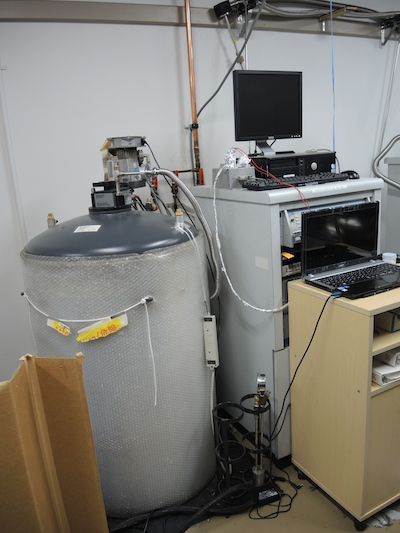 This reaches 0.3 K and 7 Tesla.
This reaches 0.3 K and 7 Tesla.
Magnetic Property Measurement System(MPMS)
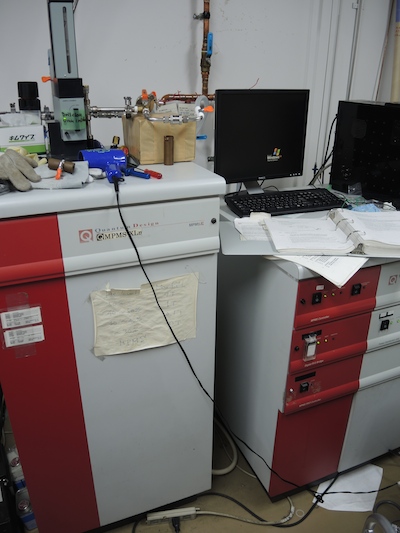 Magnetization measurement instrument with SQUID.
This covers from 1.8K to 800K and to 7 Tesla.
Magnetization measurement instrument with SQUID.
This covers from 1.8K to 800K and to 7 Tesla.
Capacitance Measurement Probe (C-dipper)
 We can measure capacitance by inserting this into a helium vessel.
We can measure capacitance by inserting this into a helium vessel.
Pressure cells
Piston-cylinder cell
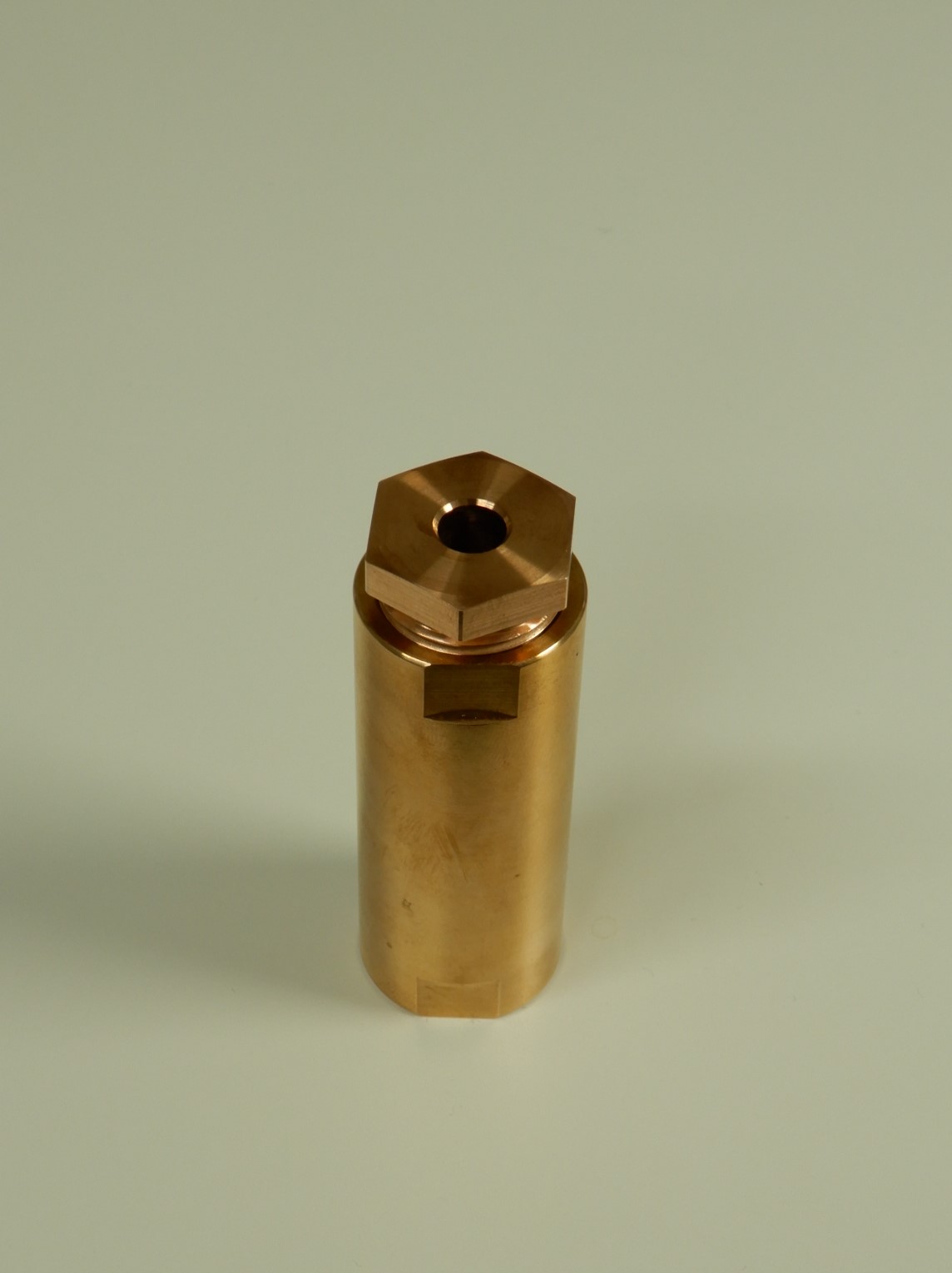 This pressure cell has a large (> 100 mm3) sample space.
We can apply 2.5 GPa at maximum using this cell.
This can be cooled down to 80 mK using a dilution refrigerator for NMR measurement.
This pressure cell has a large (> 100 mm3) sample space.
We can apply 2.5 GPa at maximum using this cell.
This can be cooled down to 80 mK using a dilution refrigerator for NMR measurement.
Indenter cell
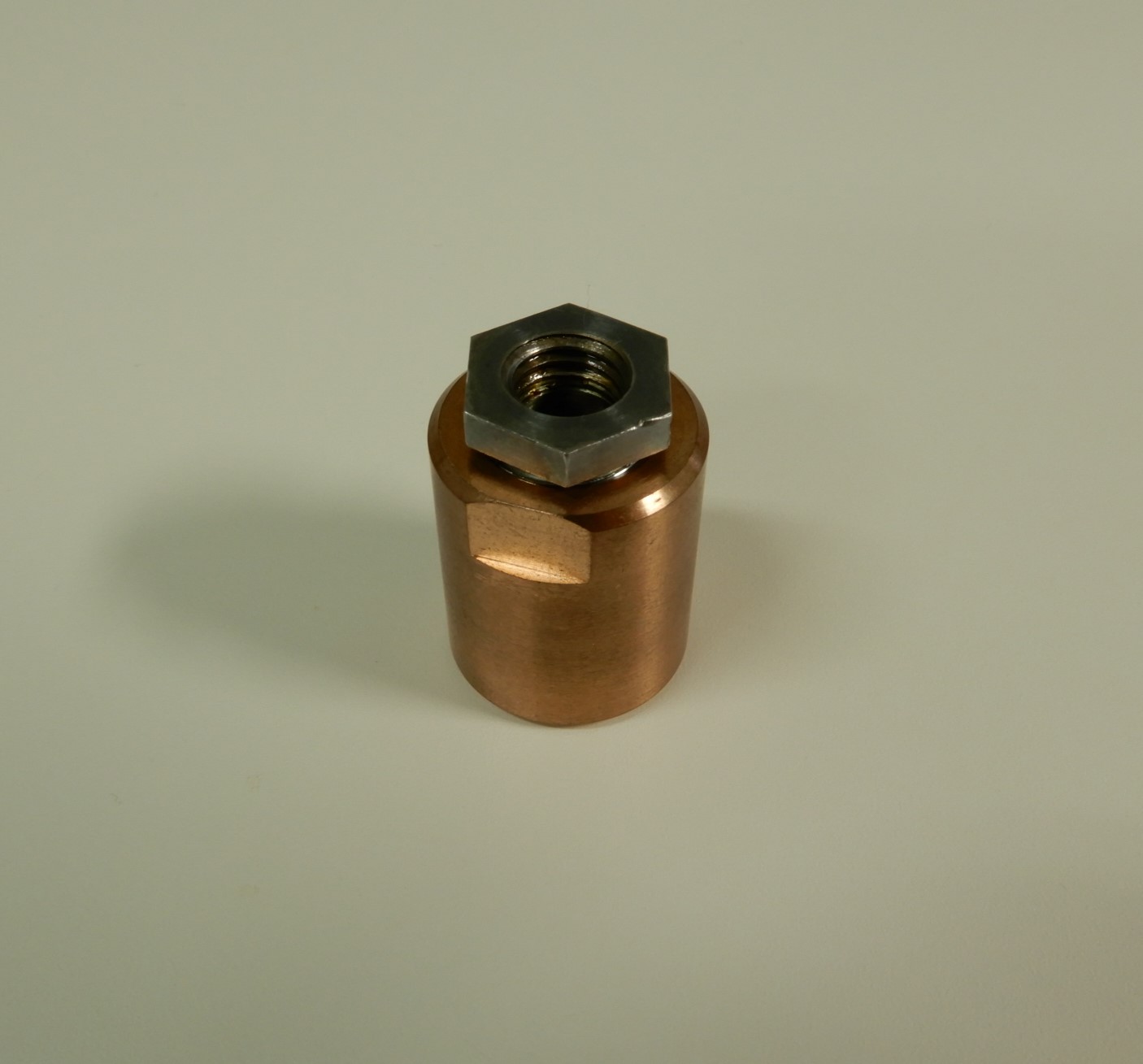 This compact pressure cell can reach to about 4.5 GPa.
This compact pressure cell can reach to about 4.5 GPa.
NMR and NQR
Glass Dewar
 A small Dewar for the nuclear quadrupole resonance (NQR) without a magnet.
This is equipped with a N2 jacket, and reaches 1.3 K.
A small Dewar for the nuclear quadrupole resonance (NQR) without a magnet.
This is equipped with a N2 jacket, and reaches 1.3 K.
5 Tesla Transverse Field Split Magnet
 We can measure field-angle dependence by rotating the probe.
This is equipped with a N2 jacket and has excellent heat retaining property.
We need helium transfer only every ten days.
We can measure field-angle dependence by rotating the probe.
This is equipped with a N2 jacket and has excellent heat retaining property.
We need helium transfer only every ten days.
NQR Dewar
 A Dewar for NQR without a magnet.
A Dewar for NQR without a magnet.
8 Tesla Transverse Field Split Magnet
 We can measure field-angle dependence by rotating the probe.
This transverse field magnet (max: 8 Tesla) has high homogeneity of a magnetic field for NMR measurement.
We can measure field-angle dependence by rotating the probe.
This transverse field magnet (max: 8 Tesla) has high homogeneity of a magnetic field for NMR measurement.
New 15T Magnet
 This reaches 15 Tesla with high homogeneity of a field (10ppm/cm3).
This is equipped with a N2 jacket, and
we need helium transfer only once in a week.
This reaches 15 Tesla with high homogeneity of a field (10ppm/cm3).
This is equipped with a N2 jacket, and
we need helium transfer only once in a week.
Oxford 15/17T Magnet
 (Used till Aug. 2018.) This reaches 15 Tesla normally and 17 Tesla with a pump.
(Used till Aug. 2018.) This reaches 15 Tesla normally and 17 Tesla with a pump.
16T Magnet
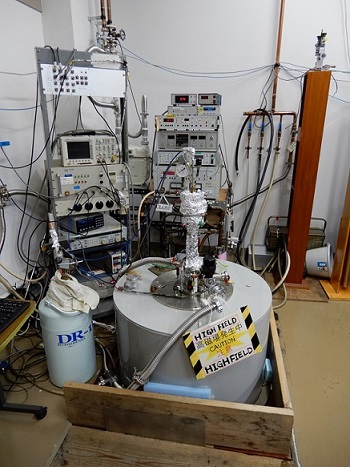 (Used since Sept. 2018.) This reaches 16 Tesla at maximum and has a high homogeneity suitable for NMR.
He transfer is done every 3-4 days and consumes about 90 L.
(Used since Sept. 2018.) This reaches 16 Tesla at maximum and has a high homogeneity suitable for NMR.
He transfer is done every 3-4 days and consumes about 90 L.
Dilution Refrigerator for NMR
 A compact dilution refrigerator for NMR and NQR.
This can be used in the above Dewars except for the glass Dewar.
This reaches about 60 mK, and the samples are directly immersed into 3He-4He mixture.
We have three dilution refrigerators for NMR and NQR, and one of them can be used for pressure measurements.
A compact dilution refrigerator for NMR and NQR.
This can be used in the above Dewars except for the glass Dewar.
This reaches about 60 mK, and the samples are directly immersed into 3He-4He mixture.
We have three dilution refrigerators for NMR and NQR, and one of them can be used for pressure measurements.